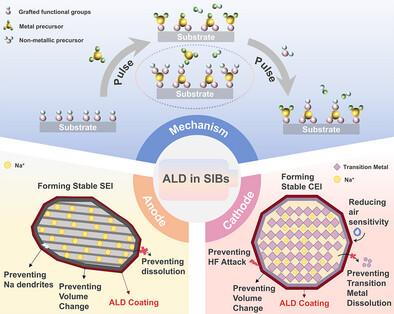Atomic Layer Deposition for Sodium-Ion Batteries
IF 26
1区 材料科学
Q1 CHEMISTRY, PHYSICAL
引用次数: 0
Abstract
Sodium (Na)-ion batteries (SIBs) have emerged as a sustainable alternative to lithium (Li)-ion counterparts due to sodium's abundance and cost-effectiveness. However, the larger ionic radius and higher mass of Na+ compared to Li⁺ induce sluggish Na⁺ intercalation kinetics within electrode materials, compromising energy density, rate capability, and lifespan. Atomic layer deposition (ALD) presents a promising approach for addressing these issues. This technique can not only synthesize favorable nanostructured coatings/electrodes to accelerate Na+ diffusion but also precisely control their thickness to reduce unnecessary mass loading. Over the past five years, research on ALD in SIBs has surged, particularly in cathode applications. However, a comprehensive review focusing specifically on ALD in SIBs remains absent. This review aims to bridge that gap by analyzing key studies published in recent years. First, the ALD techniques as applied in SIBs are outlined, covering their fundamental process, key parameters, common coating materials, and historical development. Next, the applications of ALD on various anodes, cathodes, and solid-state electrolytes are categorized and summarized, with a particular emphasis on ALD's roles in enhancing SIBs' performance. Finally, the challenges and possible future directions of ALD in SIBs are discussed, aiming to accelerate R&D for practical applications and the commercialization of SIBs.

钠离子电池的原子层沉积
钠(Na)离子电池(SIBs)已成为锂(Li)离子电池的可持续替代品,因为钠的丰度和成本效益。然而,与Li +相比,更大的离子半径和更高的Na+质量会导致Na+在电极材料中的插层动力学缓慢,影响能量密度、速率能力和寿命。原子层沉积(ALD)为解决这些问题提供了一种很有前途的方法。该技术不仅可以合成有利于Na+扩散的纳米结构涂层/电极,还可以精确控制其厚度,减少不必要的质量负荷。在过去的五年中,对sib中ALD的研究激增,特别是在阴极应用方面。然而,专门针对sib中ALD的全面审查仍然缺乏。这篇综述旨在通过分析近年来发表的关键研究来弥合这一差距。首先,概述了ALD技术在sib中的应用,包括其基本工艺、关键参数、常用涂层材料和历史发展。接下来,对ALD在各种阳极、阴极和固态电解质上的应用进行了分类和总结,特别强调了ALD在提高sib性能方面的作用。最后,讨论了ALD在sib中的挑战和可能的未来方向,旨在加快sib的实际应用和商业化的研发。
本文章由计算机程序翻译,如有差异,请以英文原文为准。
求助全文
约1分钟内获得全文
求助全文
来源期刊

Advanced Energy Materials
CHEMISTRY, PHYSICAL-ENERGY & FUELS
CiteScore
41.90
自引率
4.00%
发文量
889
审稿时长
1.4 months
期刊介绍:
Established in 2011, Advanced Energy Materials is an international, interdisciplinary, English-language journal that focuses on materials used in energy harvesting, conversion, and storage. It is regarded as a top-quality journal alongside Advanced Materials, Advanced Functional Materials, and Small.
With a 2022 Impact Factor of 27.8, Advanced Energy Materials is considered a prime source for the best energy-related research. The journal covers a wide range of topics in energy-related research, including organic and inorganic photovoltaics, batteries and supercapacitors, fuel cells, hydrogen generation and storage, thermoelectrics, water splitting and photocatalysis, solar fuels and thermosolar power, magnetocalorics, and piezoelectronics.
The readership of Advanced Energy Materials includes materials scientists, chemists, physicists, and engineers in both academia and industry. The journal is indexed in various databases and collections, such as Advanced Technologies & Aerospace Database, FIZ Karlsruhe, INSPEC (IET), Science Citation Index Expanded, Technology Collection, and Web of Science, among others.
 求助内容:
求助内容: 应助结果提醒方式:
应助结果提醒方式:


